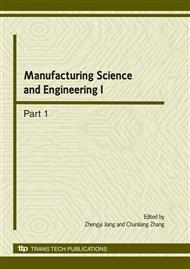p.120
p.126
p.130
p.135
p.140
p.145
p.149
p.153
p.158
Influence of Hot Working Conditions on Mechanical Properties and Microstructures at Weld Zone of the Ti3Al /TC4 Dual Alloy
Abstract:
The influences of different hot working conditions on the microstructures and mechanical properties at weld zone of the Ti3Al/TC4 dual alloy have been investigated. The experimental results show that forging and heat treatment has significant influence on room temperature tensile strength (RTTS for short) of the weld zone. The influence of forging strain and temperature on its elongation at temperature 500°C is also conspicuous. The results of intuitional and variance analysis show that affecting factors of its RTTS are heat treatment, forging strain, forge temperature and condition of billet in sequence. The affecting factors of its room temperature (RT for short) ductility and the tensile strength (TS for short) at temperature 500 °C are forging strain, forge temperature, heat treatment and condition of billet. Good comprehensive properties are obtained under optimal conditions: forging at 1020°C, annealing at 700°C for 12 hours, air cooled, about 40% strain and as-rolled billet. The microstructures of the weld zone worked according as those conditions are uniform and the grain size is also fine.
Info:
Periodical:
Pages:
140-144
Citation:
Online since:
March 2010
Authors:
Price:
Сopyright:
© 2010 Trans Tech Publications Ltd. All Rights Reserved
Share:
Citation:


